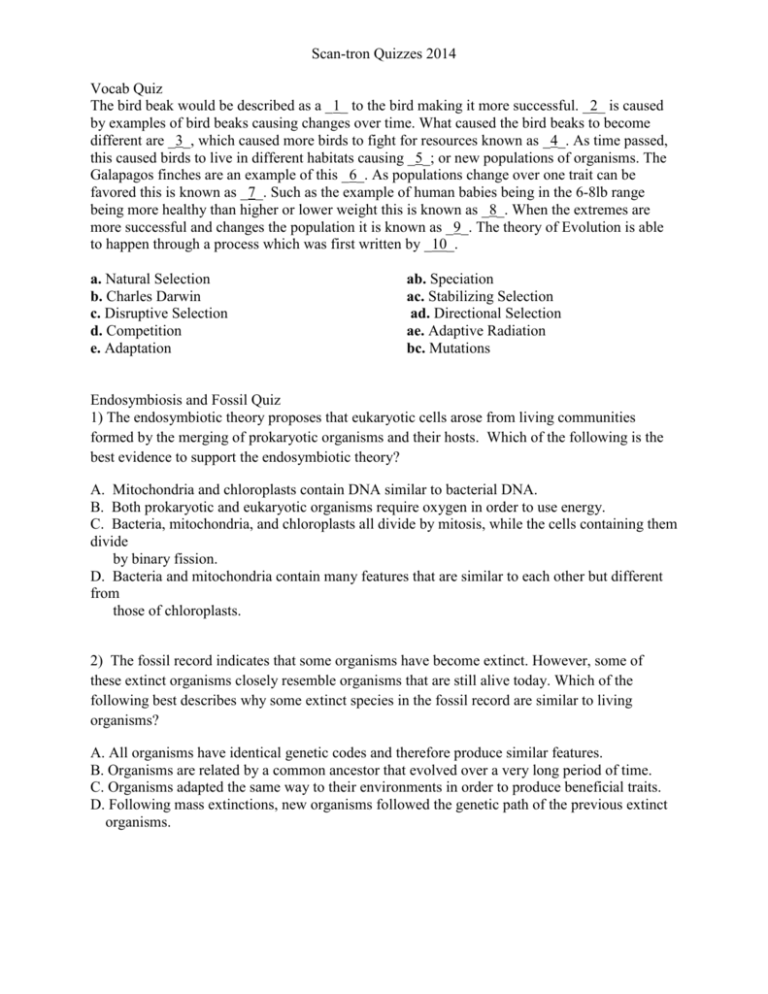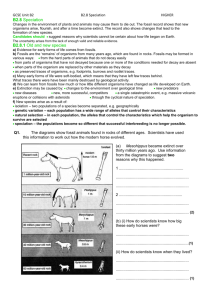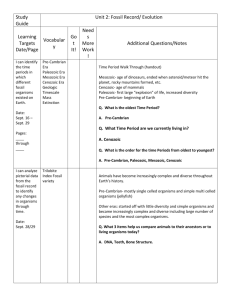Scanstron Quizzes 2014
advertisement

Scan-tron Quizzes 2014 Vocab Quiz The bird beak would be described as a _1_ to the bird making it more successful. _2_ is caused by examples of bird beaks causing changes over time. What caused the bird beaks to become different are _3_, which caused more birds to fight for resources known as _4_. As time passed, this caused birds to live in different habitats causing _5_; or new populations of organisms. The Galapagos finches are an example of this _6_. As populations change over one trait can be favored this is known as _7_. Such as the example of human babies being in the 6-8lb range being more healthy than higher or lower weight this is known as _8_. When the extremes are more successful and changes the population it is known as _9_. The theory of Evolution is able to happen through a process which was first written by _10_. a. Natural Selection b. Charles Darwin c. Disruptive Selection d. Competition e. Adaptation ab. Speciation ac. Stabilizing Selection ad. Directional Selection ae. Adaptive Radiation bc. Mutations Endosymbiosis and Fossil Quiz 1) The endosymbiotic theory proposes that eukaryotic cells arose from living communities formed by the merging of prokaryotic organisms and their hosts. Which of the following is the best evidence to support the endosymbiotic theory? A. Mitochondria and chloroplasts contain DNA similar to bacterial DNA. B. Both prokaryotic and eukaryotic organisms require oxygen in order to use energy. C. Bacteria, mitochondria, and chloroplasts all divide by mitosis, while the cells containing them divide by binary fission. D. Bacteria and mitochondria contain many features that are similar to each other but different from those of chloroplasts. 2) The fossil record indicates that some organisms have become extinct. However, some of these extinct organisms closely resemble organisms that are still alive today. Which of the following best describes why some extinct species in the fossil record are similar to living organisms? A. All organisms have identical genetic codes and therefore produce similar features. B. Organisms are related by a common ancestor that evolved over a very long period of time. C. Organisms adapted the same way to their environments in order to produce beneficial traits. D. Following mass extinctions, new organisms followed the genetic path of the previous extinct organisms. 3) Fossils usually provide paleontologists with information about each of the following EXCEPT an organism’s A. structure. B. environment. C. way of life. D. DNA. 4) Fossils sometimes show that a single species or a small group of species has evolved into diverse forms that live in different ways. An example of this would be a group of present-day mammals all having a common ancestor. Which term describes this phenomenon? A. adaptive radiation B. convergent evolution C. gradualism D. mutualism 5) Biologists have considered two different explanations to the rate of evolution: gradualism and punctuated equilibrium. How would the fossil record indicate that an organism had evolved via punctuated equilibrium? A. The fossil record would show a slow, steady rate of change from a common ancestor. B. The fossil record would be incomplete, and numerous holes would exist within the ancestral record. C. The fossil record would show rapid change over an extended period of time, with occasional periods of little change. D. The fossil record would show little change over long periods of time, followed by a sudden, brief period of rapid change. “Origin of Species” and Cladograms NAME______________ 1) _____ 2) _____ What do you call this diagram that shows evolutionary relationships among a group of organisms? a. cladogram b. phylogeny c. binomial nomenclature d. dichotomous key According to the diagram, what organism would be most closely related to the mouse? a. hagfish b. perch c. lizard d. pigeon 3 _____Different finch species have beaks of different shapes and sizes. These different beak structures are evidence of a. different finch species adapting to different environments over many generations. b. different finch species with different beak structures coming to the Galápagos Islands from the mainland. c. different finch populations being evolutionarily related. d. individual birds changing their beak characteristics so that they could feed efficiently. 4_______Which is the most likely explanation for the presence of 13 different finch species on the Galápagos Islands today? a. Many years ago several different species of birds migrated to the islands and the 13 finch species that currently live there are the only species that survived. b. Many years ago a small population of a single bird species migrated to the islands and evolved into the 13 species that live on the islands today. c. Each of the 13 species has migrated to the islands at different times over the years. d. A single bird species migrated to one island at around the time of Charles Darwin’s voyage to the Galápagos and then migrated to all 13 islands. 5______Which statement or statements describes geographically isolated populations? (Read the five statements below and then select the appropriate answer, a–d.) i. The two populations live on different islands. ii. One population breeds in late spring and the other population breeds in late summer. iii. One population eats mostly small, soft seeds and the other population eats mostly large, hard seeds. iv. The males of one population have different mating calls than the males of the other population. v. The females of the two populations look the same. a. statement i only b. statements i and iv only c. statements ii, iii, and v only d. statement iv only









